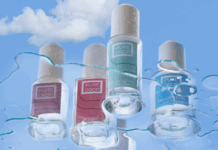As the skin ages, its biomechanical properties deteriorate, and in particular, its elasticity is lost, leading to sagging. The elastic fibers of the dermis are the main elements that give skin its elasticity and resilience. But over time, their organization and functionality deteriorate, making them a key target for anti-aging cosmetic strategies.
Skin substitutes developed by tissue bioengineering, readily available on the market today, remain imperfect models for studying skin elasticity. Indeed, they contain exogenous and artificial supports that bias the measurement of biomechanical properties in said tissues. The development of a suitable model for mechanically studying a tissue structure such as skin was therefore necessary.
The Gattefossé laboratories have developed a new dermal micro-tissue model that does away with the need for culture matrices, enabling the measurement of in vitro intrinsic elastic properties of the dermis. To assess the elasticity of these skin micro-tissues called spheroids, Gattefossé chose BioMeca's expertise to carry out an innovative analytical assessment using cutting-edge technologies.
"Characterizing biological models to assess the effect of active ingredients and cosmetic products on restoring and maintaining skin homeostasis is essential today. BioMeca offers cutting-edge technologies to meet the challenges of cutaneous biology. Under quasi-physiological conditions and over time, second harmonic microscopy highlights and images fibrous networks, while atomic force microscopy assesses tissue rigidity. Topographical and mechanical studies, quantification and nanomechanical characterization of tissues: BioMeca's expertise is a key to exploring the elastic properties of skin models, and opens the door to a better understanding of skin biomechanics".emphasizes Julien Chlasta, co-founder and President of BioMeca.
Spheroid culture has the advantage of using the cells' ability to secrete their own extracellular matrix, to produce in vitro their own tissue microenvironment. This technology has enabled Gattefossé to produce in vitro hundreds of microtissues in just a few days, from dermal fibroblasts grown in plates with very low cell adhesion. The elastic modulus (or Young's modulus) was then quantified by atomic force microscopy (AFM), and the elastic fibers visualized by second harmonic generation (SHG) microscopy. Gattefossé and BioMeca have thus demonstrated the reliability and relevance of this micro-tissue model, whose complex organization forms a dense network of mature elastic fibers sufficiently extensive to model in vitro dermal elastic mechanics.
The development of the spheroid microtissue model was presented at the 31st IFSCC congress in Yokohama at the end of 2020.
"By combining two state-of-the-art analytical techniques, second harmonic generation (SHG) microscopy and atomic force microscopy (AFM), we accurately correlated the presence and quantity of elastic fibers with the elastic properties of the microtissues, demonstrating that the newly formed elastic fibers were functional."said Dr. Nicolas Bechetoille, Head of Cutaneous Biology Research at Gattefossé.
This skin micro-tissue model was used to measure the efficacy of EleVastin, the new cosmetic active ingredient developed by Gattefossé, fighting skin slackening, which will be launched in April 2021.








